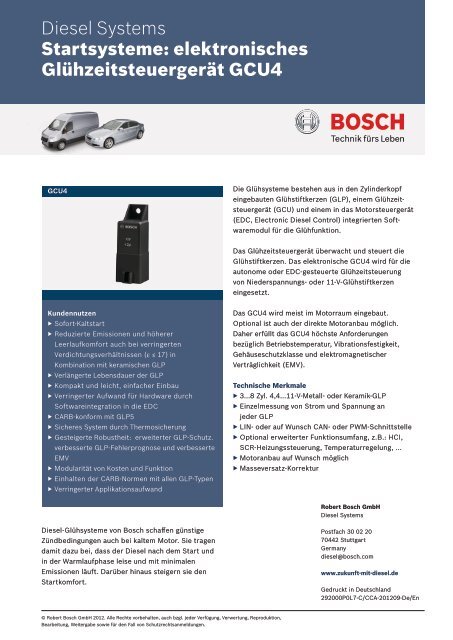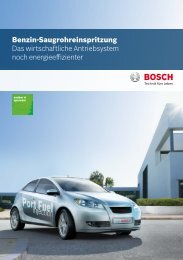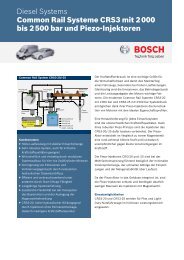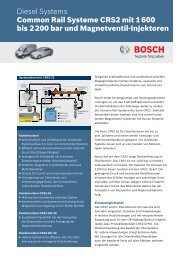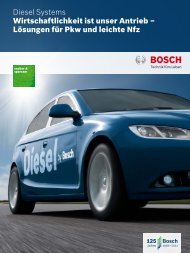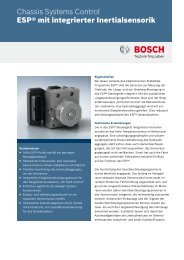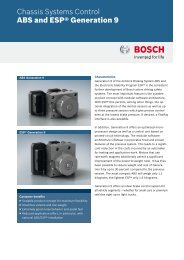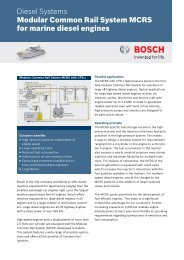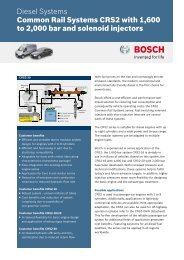Datenblatt Glühzeitsteuergerät GCU4 - Bosch - Kraftfahrzeugtechnik
Datenblatt Glühzeitsteuergerät GCU4 - Bosch - Kraftfahrzeugtechnik
Datenblatt Glühzeitsteuergerät GCU4 - Bosch - Kraftfahrzeugtechnik
Create successful ePaper yourself
Turn your PDF publications into a flip-book with our unique Google optimized e-Paper software.
Diesel Systems<br />
Startsysteme: elektronisches<br />
<strong>Glühzeitsteuergerät</strong> <strong>GCU4</strong><br />
<strong>GCU4</strong><br />
Kundennutzen<br />
▶ Sofort-Kaltstart<br />
▶ Reduzierte Emissionen und höherer<br />
Leerlaufkomfort auch bei verringerten<br />
Verdichtungsverhältnissen (e ≤ 17) in<br />
Kombination mit keramischen GLP<br />
▶ Verlängerte Lebensdauer der GLP<br />
▶ Kompakt und leicht, einfacher Einbau<br />
▶ Verringerter Aufwand für Hardware durch<br />
Softwareintegration in die EDC<br />
▶ CARB-konform mit GLP5<br />
▶ Sicheres System durch Thermosicherung<br />
▶ Gesteigerte Robustheit: erweiterter GLP-Schutz.<br />
verbesserte GLP-Fehlerprognose und verbesserte<br />
EMV<br />
▶ Modularität von Kosten und Funktion<br />
▶ Einhalten der CARB-Normen mit allen GLP-Typen<br />
▶ Verringerter Applikationsaufwand<br />
Diesel-Glühsysteme von <strong>Bosch</strong> schaffen günstige<br />
Zündbedingungen auch bei kaltem Motor. Sie tragen<br />
damit dazu bei, dass der Diesel nach dem Start und<br />
in der Warmlaufphase leise und mit minimalen<br />
Emissionen läuft. Darüber hinaus steigern sie den<br />
Startkomfort.<br />
© Robert <strong>Bosch</strong> GmbH 2012. Alle Rechte vorbehalten, auch bzgl. jeder Verfügung, Verwertung, Reproduktion,<br />
Bearbeitung, Weitergabe sowie für den Fall von Schutzrechtsanmeldungen.<br />
Die Glühsysteme bestehen aus in den Zylinderkopf<br />
eingebauten Glühstiftkerzen (GLP), einem Glühzeitsteuer<br />
gerät (GCU) und einem in das Motorsteuergerät<br />
(EDC, Electronic Diesel Control) integrierten Soft-<br />
waremodul für die Glühfunktion.<br />
Das <strong>Glühzeitsteuergerät</strong> überwacht und steuert die<br />
Glühstiftkerzen. Das elektronische <strong>GCU4</strong> wird für die<br />
autonome oder EDC-gesteuerte Glühzeitsteuerung<br />
von Niederspannungs- oder 11-V-Glühstiftkerzen<br />
eingesetzt.<br />
Das <strong>GCU4</strong> wird meist im Motorraum eingebaut.<br />
Optional ist auch der direkte Motoranbau möglich.<br />
Daher erfüllt das <strong>GCU4</strong> höchste Anforderungen<br />
bezüglich Betriebstemperatur, Vibrationsfestigkeit,<br />
Gehäuseschutzklasse und elektromagnetischer<br />
Verträglichkeit (EMV).<br />
Technische Merkmale<br />
▶ 3...8 Zyl. 4,4...11-V-Metall- oder Keramik-GLP<br />
▶ Einzelmessung von Strom und Spannung an<br />
jeder GLP<br />
▶ LIN- oder auf Wunsch CAN- oder PWM-Schnittstelle<br />
▶ Optional erweiterter Funktionsumfang, z.B.: HCI,<br />
SCR-Heizungssteuerung, Temperaturregelung, …<br />
▶ Motoranbau auf Wunsch möglich<br />
▶ Masseversatz-Korrektur<br />
Robert <strong>Bosch</strong> GmbH<br />
Diesel Systems<br />
Postfach 30 02 20<br />
70442 Stuttgart<br />
Germany<br />
diesel@bosch.com<br />
www.zukunft-mit-diesel.de<br />
Gedruckt in Deutschland<br />
292000P0L7-C/CCA-201209-De/En
Diesel Systems<br />
Starting Devices: Electronic<br />
Glow Control Unit <strong>GCU4</strong><br />
<strong>GCU4</strong><br />
Customer benefits<br />
▶ Instant cold start<br />
▶ Reduced emissions and higher cold idle<br />
comfort even at reduced compression ratios<br />
(e ≤ 17) in combination with ceramic GLP<br />
▶ Increased life time of GLP<br />
▶ Small volume and light weight, easy assembly<br />
▶ Reduced hardware expense due to software<br />
integrated in EDC<br />
▶ CARB compliance with GLP5<br />
▶ Safe system due to thermal fuse concept<br />
▶ Increased robustness: enhanced GLP protection,<br />
enhanced GLP failure prediction and improved<br />
EMI<br />
▶ Modularity of cost and function<br />
▶ CARB compliance with all GLP types<br />
▶ Reduction of application effort<br />
Diesel glow systems from <strong>Bosch</strong> create favorable<br />
conditions for ignition even with a cold engine. They<br />
help diesel engines to run quietly and with minimum<br />
emissions during the start and warm-up phases. In<br />
addition they increase starting convenience.<br />
© Robert <strong>Bosch</strong> GmbH 2012. All rights reserved, also regarding any disposal, exploitation, reproduction,<br />
editing, distribution, as well as in the event of applications for industrial property rights<br />
The glow systems consist of glow plugs built into<br />
the cylinder head, a glow control unit (GCU), and a<br />
software module integrated into the engine control<br />
unit (EDC, Electronic Diesel Control) for the glow<br />
function.<br />
The glow control unit (GCU) monitors and controls<br />
the glow plugs (GLP) in an open loop. The electronic<br />
GCU is used for stand-alone or EDC-based glow<br />
control of low voltage and 11 V glow plugs.<br />
The <strong>GCU4</strong> is generally mounted within the engine<br />
compartment and as an option can also be mounted<br />
directly on the engine. Therefore the <strong>GCU4</strong> fulfills<br />
highest requirements regarding operating temperature,<br />
vibration, housing protection as well as<br />
electromagnetic interference (EMI).<br />
Features<br />
▶ 3...8 cyl. 4.4...11 V metal or ceramic GLP<br />
▶ Individual GLP current and voltage measurement<br />
▶ LIN or optional CAN or PWM interface<br />
▶ Optional extended functions e.g.: HCI,<br />
SCR-heater control, closed-loop T-control, …<br />
▶ Optional engine mount<br />
▶ Correction of ground offset voltage<br />
Robert <strong>Bosch</strong> GmbH<br />
Diesel Systems<br />
Postfach 30 02 20<br />
70442 Stuttgart<br />
Germany<br />
diesel@bosch.com<br />
www.future-with-diesel.com<br />
Printed in Germany<br />
292000P0L7-C/CCA-201209-De/En


